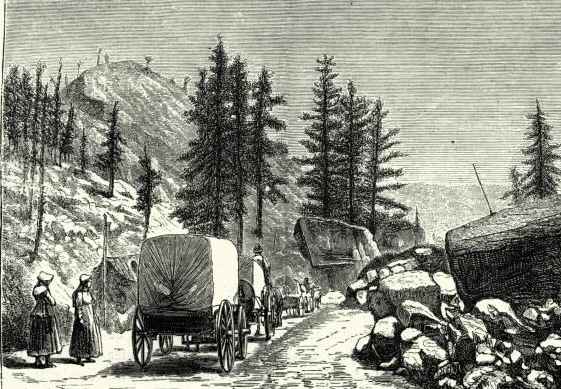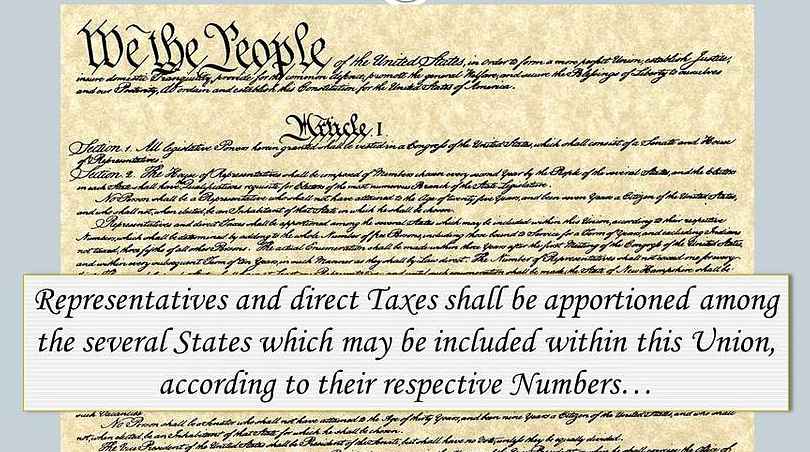






See listing of Recent and Most Popular articles on the Home Page
My World
Category: Government & Politics / Topics: Demographics • Government • History • Policy, Policy Formation • Politics
Constitution Day and the Census
Submitted by Stu Johnson
Posted: September 17, 2019
It was Hamilton versus Jefferson from the very beginning…
Editor's Note: There is much concern today about the intensity of political division in the U.S. Yet, it has been part of the fabric of American political life and government from the very start. One area of intense disagreement was how representation in the new government was to be apportioned. That is the focus of the latest "America Counts" article from the U.S. Census Bureau. A few throughts before presenting that article.
For the Founders, the issue of slavery was so divisive that it nearly aborted the adoption of the Constitution and the union of the 13 states. A major part of the compromise was allowing inclusion of slaves in the enumeration for representation, but only counting them as 3/5th of a person. This only made the issue of slavery grow more divisive, until the Civil War tore the United States in two. The 13th Amendment to the Constitution abolished slavery, the 14th Amendment gave full apportionment of representation and citizenship, but not the right to vote, which was still limited essentially to men of means. (In 1870, the 15th Amendment extended the right to vote to all male citizens 21 and older, regardless of race or color. The 19th Amendment in 1920 extended the right to vote to women. The 24th Amendment of 1964 made it illegal to require voters to pay a poll tax. The 26th Amendment of 1971 lowered the voting age from 21 to 18. The right to vote is granted to U.S. citizens.)
Today we face arguments about the impact of counting non-citizens (especially illegal immigrants) because of the way that representation and some federal funding is tied to the Census (covered in the article below). I have personally made much use of Census Bureau data for research on demographics and trends. I am concerned about the use of data for political advantage, exacerbating division rather than advancing the ideals represented in our Constitution, which spring from the Declaration of Independence.
From the very beginning, Alexander Hamilton and Thomas Jefferson disagreed.
In the popular Broadway musical Hamilton, the titular character Hamilton sings about his ongoing feuds with the then-secretary of state, Jefferson: “We have fought on like 75 different fronts.”
And they did — on everything from creating a national bank to, yes, about how to conduct the first census.
The U.S. Constitution mandated a population count of every person who lived in the new nation. But Hamilton and Jefferson disagreed about how to use the census count to grant state political representation in Congress.
President George Washington broke the stalemate and used the presidential veto for the very first time. He eventually approved a variation of Jefferson’s apportionment method.
Tuesday, people will gather on Independence Mall in Philadelphia to observe the day the Constitution was signed in this city on Sept. 17, 1787.
In Philadelphia and in cities across the country, residents will celebrate Constitution Day with cake-cuttings in museums, educational programs, and historical skits featuring “Hamilton,” “Jefferson,” and “James Madison,” who advocated adding more questions to the census in the future.
Constitution Day also is a reminder of how the census reflects the nation’s past and shapes the future.
“It is fitting for the Census Bureau to celebrate Constitution Day with the people of Philadelphia as we look toward the 2020 Census next spring,” said U.S. Census Bureau Director Steven Dillingham. “The census is not only a head count of our nation, but it is a history of the people of this country since our founding.”
How the Census Decides Political Representation
Nearly 230 years ago, before Hamilton died dueling Vice President Aaron Burr in 1804, he faced Jefferson in the political arena. They clashed on nearly every issue, including how to use the count of every person in the nascent nation.
Their main dispute was over how the census would determine congressional representation for the states. It all came down to the math. They had very different ideas about the formula for determining representation based on population.
“Jefferson was adamant,” said Census Bureau Historian Sharon Tosi Lacey. “So was Hamilton, whose method was used in the first apportionment bill sent to President George Washington. After consulting with his Cabinet, Washington exercised the first-ever presidential veto and sent the bill back to Congress.”
In the end, the founders used a variation of Jefferson’s method, “even though it meant fewer seats for his home state of Virginia,” Lacey said.
Disagreements over the method of apportionment arose every 10 years as new territories gained statehood and states vied to keep or increase their number of congressional seats.
Several other apportionment methods were used until 1940, when Huntington-Hill/Equal Proportions became the permanent method, Lacey said.
Today, states can gain or lose U.S. House seats based on whether their population goes up or down.
Census and Federal Funding
Determining states’ congressional representation is just one of several important impacts of responding to the 2020 Census.
The census also informs how billions of dollars in federal funding are distributed by various federal agencies to support social services, health care, education, and transportation systems in communities around the country.
The goal of the 2020 Census is to count everyone who lives in the United States next spring. The census asks a few simple questions on topics including age, marital status, and sex.
For the first time, you can respond online, or by phone or mail.
Students and others on hand for Constitution Day celebrations will learn how and why the bureau counts people.
At the National Constitution Center, the Census Bureau is hosting a pop-up exhibit, “The Shape Your Future Experience,” which features activities that allow visitors to explore how responding to the census can impact their lives and their communities.
In classrooms across the country, a Census Bureau program called Statistics in Schools (SIS) is helping teachers educate students on how to analyze census data used in math, statistics, and social studies.
“It’s really important to build a citizen who can look at a data display and be able to make sense of it,” said Catherine Abbott, who teaches eighth-grade algebra and sixth-grade math at Martin Luther King Middle School in Beltsville, Md. “What I love about SIS is it’s real; it’s based on real data.”
Shape your future. Start here. Census 2020.
See the original article with additional links and video.
This post appeared first on Stu Johnson's InfoMatters blog on sjassociates.com.
Posted: September 17, 2019 Accessed 698 times
![]() Go to the list of most recent My World Articles
Go to the list of most recent My World Articles
![]() Search My World (You can expand the search to the entire site)
Search My World (You can expand the search to the entire site)
![]() Go to the list of Most Recent and Most Popular Articles across the site (Home Page)
Go to the list of Most Recent and Most Popular Articles across the site (Home Page)
 Loading requested view...
Loading requested view...